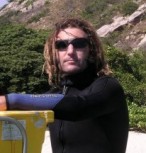DNA reveals the past and future of coral reefs
New DNA techniques are being used to understand how coral reacted to the end of the last ice age in order to better predict how they will cope with current changes to the climate. James Cook Univer

From 2005 to 2022, the main node of the ARC Centre of Excellence for Coral Reef Studies was headquartered at James Cook University in Townsville, Queensland (Australia)








Abstract: Networks of no-take marine reserves (NTMRs) are widely advocated for preserving exploited fish stocks and for conserving biodiversity. We used underwater visual survey data of coral reef fish and benthic communities to quantify the short- to medium-term (5 to 30 years) ecological effects of the establishment of NTMRs within the Great Barrier Reef Marine Park (GBRMP). The density, mean length and biomass of principal fishery species, coral trout (Plectropomus spp.), were consistently greater in NTMRs than on fished reefs over both the short- and medium-term. However, there were no clear or consistent differences in the structure of fish or benthic assemblages, non-target fish abundance, fish species richness or coral cover between NTMR and fished reefs. There was no indication that the displacement and concentration of fishing effort had reduced populations of coral trout on fished reefs. A severe tropical cyclone impacted many survey reefs during the study, causing similar declines in coral cover and fish density on both NTMR and fished reefs. However, coral trout biomass declined only on fished reefs following the cyclone. The GBRMP is performing as expected for the protection of fished stocks and biodiversity in a developed country where fishing is not excessive and targets a narrow range of species. Although NTMRs cannot directly protect coral reefs from regional-scale acute disturbance, impacted NTMR reefs supported higher biomass of key fishery-targeted species, following a strong tropical cyclone and should provide valuable sources of larvae that will enhance population recovery and long-term persistence.
Bio: Mike is an Experimental Scientist on the Long Term Monitoring Team at the Australian Institute of Marine Science, where he has worked since 2004. Prior to that he ran a marine biological consultancy and worked at Fisheries Research in Australia’s Northern Territory. Mike received a BSc Hons from JCU in 1995 and subsequently worked with Prof Geoff Jones investigating self-recruitment in coral reef fishes. Since moving to AIMS, Mike has published over 30 reports and peer-reviewed journal articles. His main research interests lie in reef fish ecology, the effect of disturbances and marine protected areas on coral reef communities and the contribution of various groups of fishes to reef resilience.
New DNA techniques are being used to understand how coral reacted to the end of the last ice age in order to better predict how they will cope with current changes to the climate. James Cook Univer
A new study on the effects of climate change in five tropical countries has found fisheries are in more trouble than agriculture, and poor people are in the most danger. Distinguished Profess
James Cook University researchers have found brightly coloured fish are becoming increasingly rare as coral declines, with the phenomenon likely to get worse in the future. Christopher Hemingson, a
Researchers working with stakeholders in the Great Barrier Reef region have come up with ideas on how groups responsible for looking after the reef can operate more effectively when the next bleaching
Abstract: As marine species adapt to climate change, their heat tolerance will likely be under strong selection. Individual variation in heat tolerance and its heritability underpin the potential fo
Abstract: The Reef Ecology Lab in KAUST’s Red Sea Research Center explores many aspects of movement ecology of marine organisms, ranging from adult migrations to intergenerational larval dispersal
Abstract: Macroalgal meadows are a prominent, yet often maligned component of the tropical seascape. Our work at Ningaloo reef in WA demonstrate that canopy forming macroalgae provide habitat for ad
Abstract: Sharks are generally perceived as strong and fearsome animals. With fossils dating back at least 420 million years, sharks are not only majestic top predators but they also outlived dinosa
Abstract: Connectivity plays a vital role in many ecosystems through its effects on fundamental ecological and evolutionary processes. Its consequences for populations and metapopulations have been
Abstract: Evolution of many eukaryotic organisms is affected by interactions with microbes. Microbial symbioses can ultimately reflect host’s diet, habitat range, and even body shape. However, how
Abstract: The past few years have seen unprecedented coral bleaching and mortality on the Great Barrier Reef (GBR) but the consequences of this on biodiversity are not yet known. This talk will expl